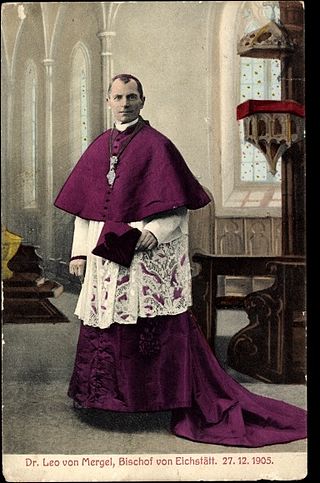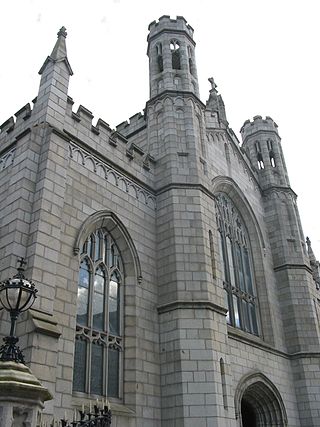
A parish is a territorial entity in many Christian denominations, constituting a division within a diocese. A parish is under the pastoral care and clerical jurisdiction of a priest, often termed a parish priest, who might be assisted by one or more curates, and who operates from a parish church. Historically, a parish often covered the same geographical area as a manor. Its association with the parish church remains paramount.
Simony is the act of selling church offices and roles or sacred things. It is named after Simon Magus, who is described in the Acts of the Apostles as having offered two disciples of Jesus payment in exchange for their empowering him to impart the power of the Holy Spirit to anyone on whom he would place his hands. The term extends to other forms of trafficking for money in "spiritual things".

An altar is a table or platform for the presentation of religious offerings, for sacrifices, or for other ritualistic purposes. Altars are found at shrines, temples, churches, and other places of worship. They are used particularly in paganism, Christianity, Buddhism, Hinduism, Judaism, modern paganism, and in certain Islamic communities around Caucasia and Asia Minor. Many historical-medieval faiths also made use of them, including the Roman, Greek, and Norse religions.
Subdeacon is a minor order of ministry for men in various branches of Christianity. The subdeacon has a specific liturgical role and is placed below the deacon and above the acolyte in the order of precedence.

A curate is a person who is invested with the care or cure of souls of a parish. In this sense, curate means a parish priest; but in English-speaking countries the term curate is commonly used to describe clergy who are assistants to the parish priest. The duties or office of a curate are called a curacy.

A Pontifical High Mass, also called Solemn Pontifical Mass, is a Solemn or High Mass celebrated by a bishop using certain prescribed ceremonies. Although in modern English the word "pontifical" is almost exclusively associated with the pope, any bishop may be properly called a pontiff. Thus, the celebrant of a Pontifical High Mass may be the pope, any bishop or any other prelate who is allowed to wear pontificals.

An altar server is a lay assistant to a member of the clergy during a Christian liturgy. An altar server attends to supporting tasks at the altar such as fetching and carrying, ringing the altar bell, helping bring up the gifts, and bringing up the liturgical books, among other things. If young, the server is commonly called an altar boy or altar girl. In some Christian denominations, altar servers are known as acolytes.
An ostiarius, a Latin word sometimes anglicized as ostiary but often literally translated as porter or doorman, originally was an slave or guard posted at the entrance of a building. See also gatekeeper.

A sacristy, also known as a vestry or preparation room, is a room in Christian churches for the keeping of vestments and other church furnishings, sacred vessels, and parish records.

Choir dress is the traditional vesture of the clerics, seminarians and religious of Christian churches worn for public prayer and the administration of the sacraments except when celebrating or concelebrating the Eucharist. It differs from the vestments worn by the celebrants of the Eucharist, being normally made of fabrics such as wool, cotton or silk, as opposed to the fine brocades used in vestments. It may also be worn by lay assistants such as acolytes and choirs. It was abandoned by most of the Protestant churches that developed from the sixteenth-century Reformation.
In English ecclesiastical law, the term incumbent refers to the holder of a Church of England parochial charge or benefice. The term "benefice" originally denoted a grant of land for life in return for services. In church law, the duties were spiritual ("spiritualities") and some form of assets to generate revenue were permanently linked to the duties to ensure the support of the office holder. Historically, once in possession of the benefice, the holder had lifelong tenure unless he failed to provide the required minimum of spiritual services or committed a moral offence. With the passing of the "Pastoral Measure 1968" and subsequent legislation, this no longer applies, and many ancient benefices have been joined into a single new one.

The Anglican ministry is both the leadership and agency of Christian service in the Anglican Communion. Ministry commonly refers to the office of ordained clergy: the threefold order of bishops, priests and deacons. More accurately, Anglican ministry includes many laypeople who devote themselves to the ministry of the church, either individually or in lower/assisting offices such as lector, acolyte, sub-deacon, Eucharistic minister, cantor, musicians, parish secretary or assistant, warden, vestry member, etc. Ultimately, all baptized members of the church are considered to partake in the ministry of the Body of Christ.
The Minor Canons of St Paul's Cathedral, London, whose origins predate the Norman conquest of England, unusually were independent of the senior canons and, as priests, of higher status than the lay vicars choral. Medieval Hereford furnishes the only other example of such a structure.

In the Catholic Church, a bishop is an ordained minister who holds the fullness of the sacrament of holy orders and is responsible for teaching doctrine, governing Catholics in his jurisdiction, sanctifying the world and representing the Church. Catholics trace the origins of the office of bishop to the apostles, who it is believed were endowed with a special charism and office by the Holy Spirit at Pentecost. Catholics believe this special charism and office has been transmitted through an unbroken succession of bishops by the laying on of hands in the sacrament of holy orders.

The altar in the Catholic Church is used for celebrating the Sacrifice of the Mass.
The under-sacristan or custos was a Roman Catholic office.

The Cathedral of Saint Patrick and Saint Colman or Newry Cathedral is a Roman Catholic cathedral located in Newry, Northern Ireland. It acts as the seat of the Bishop of Dromore, and the Mother church of the Roman Catholic Diocese of Dromore. Prior to the COVID-19 pandemic, over 200,000 people visited the cathedral each year. The cathedral sits on Newry's Main Street and is a Grade A listed building.
An altar society or altar guild is a group of laypersons in a parish church who maintain the ceremonial objects used in worship. Traditionally, membership was limited to women and their most common functions are making floral arrangements for the sanctuary, caring for linens, and holding fundraisers to purchase items for the sanctuary, including vestments and altar vessels.
A rector is, in an ecclesiastical sense, a cleric who functions as an administrative leader in some Christian denominations. In contrast, a vicar is also a cleric but functions as an assistant and representative of an administrative leader.
Edward Nason West (1909–1990) was an Episcopal priest and fixture at the Cathedral of St. John the Divine in New York City where he served for many years as canon sacrist and sub dean. He was also a theologian, an author, an internationally known iconographer and an expert in the design of church furnishings. He was the inspiration for Canon Tallis in Madeleine L'Engle's young adult novels and was Madeleine's spiritual mentor. He was a graduate of Boston University and the General Theological Seminary of the Episcopal Church. He was an Officer of the Order of the British Empire; an Officer of the Order of Orange-Nassau; a Chevalier of the Legion of Honor; and a Knight Commander of the Royal Order of St. Sava.













